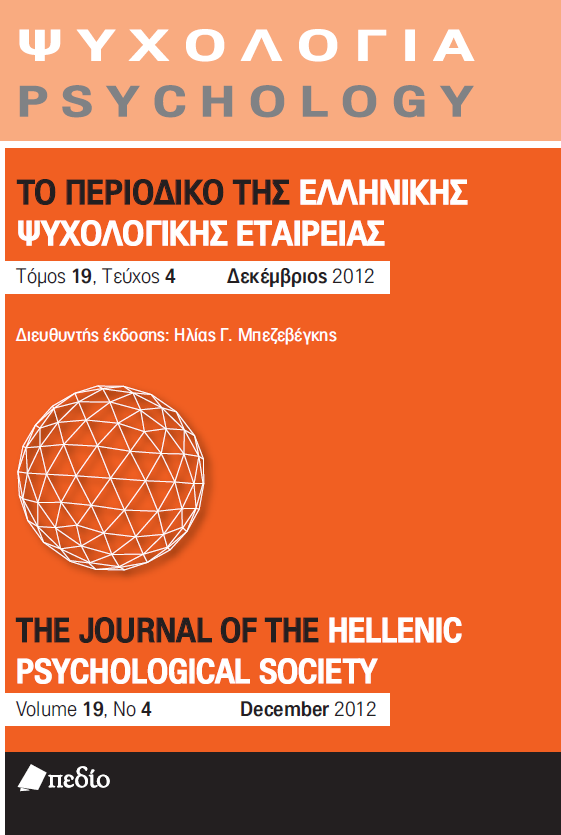Σεξουαλική επιθετικότητα νέων ανδρών και παράγοντες που την ενισχύουν

Περίληψη
Σκοπός: Η παρούσα μελέτη είχε σκοπό την εκτίμηση της συχνότητας εκδήλωσης σεξουαλικά επιθετικών συμπεριφορών σε άνδρες ηλικίας 18-30 ετών του νομού Ηρακλείου Κρήτης και την αναζήτηση παραγόντων που ενισχύουν την εκδήλωση των συμπεριφορών αυτών. Μεθοδολογία: Για την επιλογή του δείγματος εφαρμόστηκε η μέθοδος της τυχαίας στρωματοποίησης. Από σύνολο 400 επιλεγμένων οίκων βρέθηκαν 335 άτομα να πληρούν τα κριτήρια συμμετοχής στη μελέτη (φύλο και ηλικία) και από αυτά δέχτηκαν να συμμετέχουν τα 241. Για τις ανάγκες της παρούσας μελέτης χρησιμοποιήθηκε ημιδομημένο ερωτηματολόγιο, το οποίο περιελάμβανε 4 μέρη και 43 συνολικά ερωτήσεις. Το ερωτηματολόγιο εξέταζε τα κοινωνικοδημογραφικά χαρακτηριστικά των συμμετεχόντων, το ιστορικό σεξουαλικών πρακτικών και εμπειριών τους, τις στάσεις τους ως προς τους μύθους του βιασμού και τη συχνότητα εκδήλωσης σεξουαλικά επιθετικών συμπεριφορών. Αποτελέσματα:
Οι συμμετέχοντες στο σύνολό τους ήταν άνδρες (n=241) με μέση ηλικία τα 23,9 έτη (Τ.Α.=3,4). Η μέση ηλικία της πρώτης σεξουαλικής επαφής των συμμετεχόντων ήταν τα 17,2 έτη (Τ.Α.=2,0). Από το σύνολο των
συμμετεχόντων, 8 (3,3%) ανέφεραν θυματοποίηση χωρίς ολοκληρωμένη σεξουαλική πράξη σε ηλικία μικρότερη των 14 ετών και 2 (0,8%) ανέφεραν θυματοποίηση με ολοκληρωμένη σεξουαλική πράξη κατά την
ίδια ηλικία. Σύμφωνα με τα αποτελέσματα της ανάλυσης πολλαπλής παλινδρόμησης, η μεγαλύτερη αποδοχή των μύθων του βιασμού (p=0,001, ΔΕ=0,721;1,471) βρέθηκε να συνδέεται με αυξημένη πιθανότητα εκδήλωσης σεξουαλικά επιθετικών συμπεριφορών κατόπιν ελέγχου των κοινωνικοδημογραφικών χαρακτηριστικών και του ιστορικού σεξουαλικών πρακτικών και εμπειριών των συμμετεχόντων. Συμπεράσματα: Μελλοντικές προσπάθειες για την πρόληψη και αντιμετώπισή του φαινομένου της σεξουαλικής επιθετικότητας θα πρέπει να λάβουν υπόψη τους παράγοντες κινδύνου που ανέδειξε η παρούσα μελέτη.
Λεπτομέρειες άρθρου
- Πώς να δημιουργήσετε Αναφορές
-
Παπαδακάκη Μ., Τσαλκάνης Α., Αραβαντινού Α., Ευτυχίδη Ρ., Ιωσηφίδης Ι., & Χλιαουτάκης Ι. (2020). Σεξουαλική επιθετικότητα νέων ανδρών και παράγοντες που την ενισχύουν. Ψυχολογία: το περιοδικό της Ελληνικής Ψυχολογικής Εταιρείας, 19(4), 445–460. https://doi.org/10.12681/psy_hps.23699
- Τεύχος
- Τόμ. 19 Αρ. 4 (2012)
- Ενότητα
- ΘΕΩΡΗΤΙΚΕΣ ΑΝΑΣΚΟΠΗΣΕΙΣ

Αυτή η εργασία είναι αδειοδοτημένη υπό το Creative Commons Attribution-ShareAlike 4.0 International License.
Το περιοδικό ΨΥΧΟΛΟΓΙΑ έχει υιοθετήσει μία πολιτική Platinum open-access. Τα έξοδα υποβολής, επεξεργασίας ή δημοσίευσης των εργασιών καλύπτονται από την Ελληνική Ψυχολογική Εταιρεία. Τα πνευματικά δικαιώματα των δημοσιευμένων εργασιών προστατεύονται από την άδεια 'Creative Commons Attribution-ShareAlike 4.0 International'. Οι Συγγραφείς διατηρούν τα Πνευματικά Δικαιώματα και χορηγούν στο περιοδικό το δικαίωμα της πρώτης δημοσίευσης. Η άδεια αυτή επιτρέπει σε τρίτους, να χρησιμοποιούν την εργασία σε οποιαδήποτε μορφή, με την προϋπόθεση της διατήρησης των διατυπώσεων που προβλέπονται στην άδεια σχετικά με την αναφορά στον αρχικό δημιουργό και την αρχική δημοσίευση στο περιοδικό ΨΥΧΟΛΟΓΙΑ. Επιπλέον, κάθε διανομή της εργασίας οφείλει να γίνεται με τους ίδιους όρους διανομής, δηλαδή με την ίδια άδεια Creative Commons.


